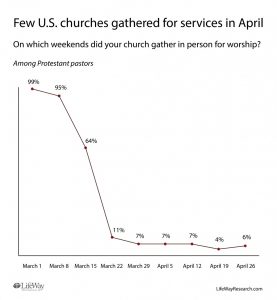 NASHVILLE (BP)—As federal, state and local governments weigh relaxing stay-at-home guidelines, most churches continued to avoid gathering physically throughout April.
NASHVILLE (BP)—As federal, state and local governments weigh relaxing stay-at-home guidelines, most churches continued to avoid gathering physically throughout April.
Nine in 10 Protestant pastors say their congregations did not meet for an in-person worship service last month, according to a new study from Nashville-based LifeWay Research.
A previous study from LifeWay Research found 99 percent of churches gathered physically at the beginning of March, but that dropped to 7 percent by March 29.
Despite Easter falling during the month, churches continued to avoid meeting in April. The latest LifeWay Research survey found those choosing to gather in person remained flat on April 5 and April 12 (Easter Sunday) at 7 percent. Fewer gathered on April 19 (4 percent) and April 26 (6 percent).
“By the end of March, the gravity of the pandemic had changed churches’ behavior across the nation,” said Scott McConnell, executive director of LifeWay Research. “The need for precautions did not change throughout April and churches maintained their temporary avoidance of gathering physically.”
Most pastors are making plans now for meeting again when local government restrictions and guidance against churches meeting are lifted, but few say they’re going to return to normal immediately.
Three in 10 (30 percent) say they plan to resume worship services first with small groups beginning to meet later. Around a quarter (23 percent) say they’re going to wait a few additional weeks and then resume activities gradually. Almost 1 in 6 (16 percent) are planning on resuming all normal activities right away, while 7 percent are starting up small groups first and in-person worship services later.
A quarter (24 percent) say they have not yet made any plans for resuming activities, and 1 percent say they never stopped their in-person activities.
Move to digital
As churches adjusted to a lack of physical gatherings in April, even more attempted to move services online.
Almost all churches (97 percent) offered some type of digital worship service option, up from 92 percent in March.
In April, around a quarter (22 percent) say they continued livestreaming their sermon or worship service as they were already doing before the pandemic.
Close to half (45 percent) say they don’t typically livestream but did so in April because of the coronavirus. Three in 10 (30 percent) say they didn’t livestream but did post a video sermon for their congregation to view at any time.
The coronavirus outbreak has caused some previously hesitant churches to adopt online giving. Almost 1 in 6 pastors (16 percent) say their church has added an online giving option since the pandemic began. Close to half (48 percent) say they continue to offer online giving as they did previously.
More than a third (35 percent) say their church does not currently offer the ability to give online.
Still, online giving among Protestant churches has grown considerably since 2017 when LifeWay Research found 30 percent offered a giving option on their website.
“The technological strides churches have made the last six weeks are amazing,” said McConnell. “Before the pandemic the majority of churches did not livestream services or offer online giving methods. Now two-thirds offer each and almost all churches have offered some online sermons or worship.”
Lasting impact
Two in 5 pastors (40 percent) say giving has decreased compared to earlier this year. A similar number (42 percent) say giving has continued at similar levels. Few (9 percent) say giving has increased, while 9 percent are not sure.
Among those who say giving is down, 3 in 10 (30 percent) say it has dropped less than 25 percent. More than half (54 percent) say giving has decreased more than 25 percent, with 18 percent reporting it being down 50 percent or more.
These numbers are less bleak than the perception of pastors in March when 52 percent said giving was down from earlier in the year, 18 percent said it was flat and 2 percent said it had increased. More than a quarter (28 percent) were not sure what to expect.
“It took a few weeks after the last offering plate was passed, but fewer churches are finding themselves behind financially from where they were before COVID-19,” said McConnell. “Members mailed checks, churches added online giving options, the worst fears receded, and generosity emerged. Yet more churches are having to work with less than we have seen in our last 10 years of tracking giving.”
Unfortunately, McConnell added, April did not bode well for future church finances as more pastors reported having church members lose jobs and working fewer hours last month.
“The lost income of attendees will challenge churches in the days ahead to do more with less and to care for the growing needs of others,” he said.
In March, 75 percent of Protestant pastors said someone in their church has had their income impacted by reduced hours at work and 42 percent said someone had lost their job. Both of those numbers increased in April. Now, 84 percent say an attendee has less income due to reduced hours and 57 percent say they’ve had someone in their congregation lose their job.
One in 5 pastors (20 percent) say an attendee has been diagnosed with COVID-19, up from 5 percent in March.
Pastors did note some positive news. Many say attendees have helped each other with tangible needs (83 percent), new people who have not attended their church in the past have attended or connected online (77 percent), and attendees have met tangible needs in their community connected to the coronavirus (71 percent).
Some say an attendee has had the opportunity to share the Gospel (35 percent). Almost 1 in 10 pastors (8 percent) say someone in their church has seen someone make a commitment to follow Christ after sharing the Gospel.
Government aid
Two in 5 Protestant pastors (40 percent) say their church has applied for government assistance offered through the CARES Act or the Small Business Administration, while 56 percent say they have not. Around a quarter (23 percent) of pastors say their application was accepted, which means that of those who applied, 59 percent were approved for assistance.
“There are a variety of motives churches have had for applying or not applying for government assistance,” said McConnell. “As the window of opportunity closes, the majority have chosen not to apply.”
The smaller the church, the less likely they were to have applied for aid. Half of pastors at churches that average 200 in attendance or more (50 percent) say their church applied for aid, with 36 percent of all large church pastors saying they’ve already been approved.
Among churches with 100 to 199 in attendance, 44 percent applied. Among pastors of churches with 50 to 99 attendees, 36 percent say they submitted an application. A third (33 percent) of churches with fewer than 50 in attendance applied.
For more information, visit LifeWayResearch.com or download the report.
Methodology:
The online survey of 470 Protestant pastors was conducted April 27-29, 2020. Invitations were emailed to the LifeWay Research Pastor Panel followed by two reminders. The probability sample of Protestant churches was created by phone recruiting by LifeWay Research using random samples selected from all Protestant churches. Pastors who agree to be contacted by email for future surveys make up this LifeWay Research Pastor Panel.
Each survey was completed by the senior or sole pastor or a minister at the church. Responses were weighted by church average attendance, region, ethnicity of pastor, and whether the pastor self-identified as evangelical or mainline to more accurately reflect the population.
The final sample is 470 usable surveys. The sample provides 95 percent confidence that the sampling error does not exceed plus or minus 5.0 percent. Margins of error are higher in sub-groups.






